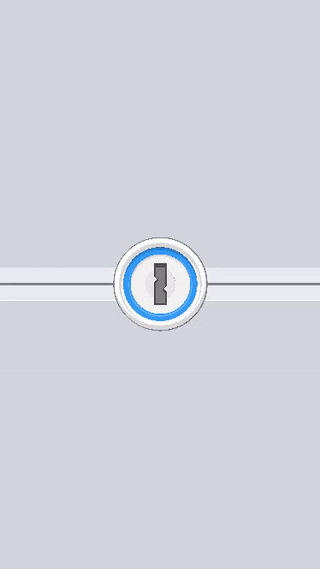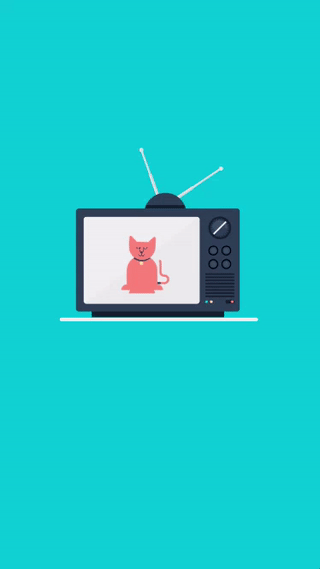收录:原文地址
前言
iOS 的动画框架很成熟,提供必要的信息,譬如动画的起始位置与终止位置,动画效果就出来了
动画的实现方式挺多的,
有系统提供的简单 API ,直接提供动画般的交互效果。
有手动设置交互效果,看起来像是动画,一般要用到插值。
至于动画框架,有 UIView 级别的,有功能强劲的 CALayer 级别的动画。
CALayer 级别的动画通过灵活设置的 CoreAnimation,CoreAnimation 的常规操作,就是自定义路径
当然有苹果推了几年的 UIViewPropertyAnimator, 动画可交互性做得比较好;
话不多说;直接来看案例
例子一:导航栏动画
navigationController?.hidesBarsOnSwipe = true
简单设置 hidesBarsOnSwipe 属性,就可以了。
该属性,除了可以调节头部导航栏,还可以调节底部标签工具栏 toolbar
例子二:屏幕开锁效果
一眼看起来有点炫,实际设置很简单
func openLock() {
UIView.animate(withDuration: 0.4, delay: 1.0, options: [], animations: {
// Rotate keyhole.
self.lockKeyhole.transform = CGAffineTransform(rotationAngle: CGFloat.pi)
}, completion: { _ in
UIView.animate(withDuration: 0.5, delay: 0.2, options: [], animations: {
// Open lock.
let yDelta = self.lockBorder.frame.maxY
self.topLock.center.y -= yDelta
self.lockKeyhole.center.y -= yDelta
self.lockBorder.center.y -= yDelta
self.bottomLock.center.y += yDelta
}, completion: { _ in
self.topLock.removeFromSuperview()
self.lockKeyhole.removeFromSuperview()
self.lockBorder.removeFromSuperview()
self.bottomLock.removeFromSuperview()
})
})
}
总共有四个控件,先让中间的锁控件旋转一下,然后对四个控件,做移位操作
用简单的关键帧动画,处理要优雅一点
例子三:地图定位波动
看上去有些眼花的动画,可以分解为三个动画
一波未平,一波又起,做一个动画效果的叠加,就成了动画的第一幅动画
一个动画波动效果,效果用到了透明度的变化,还有范围的变化
范围的变化,用的就是 CoreAnimation 的路径 path
CoreAnimation 简单设置,就是指明 from 、to,动画的起始状态,和动画终止状态,然后选择使用哪一种动画效果。
动画的起始状态,一般是起始位置。简单的动画,就是让他动起来
func sonar(_ beginTime: CFTimeInterval) {
let circlePath1 = UIBezierPath(arcCenter: self.center, radius: CGFloat(3), startAngle: CGFloat(0), endAngle:CGFloat.pi * 2, clockwise: true)
let circlePath2 = UIBezierPath(arcCenter: self.center, radius: CGFloat(80), startAngle: CGFloat(0), endAngle:CGFloat.pi * 2, clockwise: true)
let shapeLayer = CAShapeLayer()
shapeLayer.strokeColor = ColorPalette.green.cgColor
shapeLayer.fillColor = ColorPalette.green.cgColor
shapeLayer.path = circlePath1.cgPath
self.layer.addSublayer(shapeLayer)
// 两个动画
let pathAnimation = CABasicAnimation(keyPath: "path")
pathAnimation.fromValue = circlePath1.cgPath
pathAnimation.toValue = circlePath2.cgPath
let alphaAnimation = CABasicAnimation(keyPath: "opacity")
alphaAnimation.fromValue = 0.8
alphaAnimation.toValue = 0
// 组动画
let animationGroup = CAAnimationGroup()
animationGroup.beginTime = beginTime
animationGroup.animations = [pathAnimation, alphaAnimation]
// 时间有讲究
animationGroup.duration = 2.76
// 不断重复
animationGroup.repeatCount = Float.greatestFiniteMagnitude
animationGroup.isRemovedOnCompletion = false
animationGroup.fillMode = CAMediaTimingFillMode.forwards
// Add the animation to the layer.
// key 用来 debug
shapeLayer.add(animationGroup, forKey: "sonar")
}
波动效果调用了三次
func startAnimation() {
// 三次动画,效果合成,
sonar(CACurrentMediaTime())
sonar(CACurrentMediaTime() + 0.92)
sonar(CACurrentMediaTime() + 1.84)
}
例子四:加载动画
这是 UIView 框架自带的动画,看起来不错,就是做了一个简单的缩放,通过 transform 属性做仿射变换
func startAnimation() {
dotOne.transform = CGAffineTransform(scaleX: 0.01, y: 0.01)
dotTwo.transform = CGAffineTransform(scaleX: 0.01, y: 0.01)
dotThree.transform = CGAffineTransform(scaleX: 0.01, y: 0.01)
// 三个不同的 delay, 渐进时间
UIView.animate(withDuration: 0.6, delay: 0.0, options: [.repeat, .autoreverse], animations: {
self.dotOne.transform = CGAffineTransform.identity
}, completion: nil)
UIView.animate(withDuration: 0.6, delay: 0.2, options: [.repeat, .autoreverse], animations: {
self.dotTwo.transform = CGAffineTransform.identity
}, completion: nil)
UIView.animate(withDuration: 0.6, delay: 0.4, options: [.repeat, .autoreverse], animations: {
self.dotThree.transform = CGAffineTransform.identity
}, completion: nil)
}
例子五:下划线点击转移动画
这个也是 UIView 的动画
动画的实现效果,是通过更改约束。
约束动画要注意的是,确保动画的起始位置准确,起始的时候,一般要调用其父视图的 layoutIfNeeded 方法,确保视图的实际位置与约束设置的一致。
这里的约束动画,是通过 NSLayoutAnchor 做得。
一般我们用的是 SnapKit 设置约束,调用也差不多。
func animateContraintsForUnderlineView(_ underlineView: UIView, toSide: Side) {
switch toSide {
case .left:
for constraint in underlineView.superview!.constraints {
if constraint.identifier == ConstraintIdentifiers.centerRightConstraintIdentifier {
constraint.isActive = false
let leftButton = optionsBar.arrangedSubviews[0]
let centerLeftConstraint = underlineView.centerXAnchor.constraint(equalTo: leftButton.centerXAnchor)
centerLeftConstraint.identifier = ConstraintIdentifiers.centerLeftConstraintIdentifier
NSLayoutConstraint.activate([centerLeftConstraint])
}
}
case .right:
for constraint in underlineView.superview!.constraints {
if constraint.identifier == ConstraintIdentifiers.centerLeftConstraintIdentifier {
// 先失效,旧的约束
constraint.isActive = false
// 再新建约束,并激活
let rightButton = optionsBar.arrangedSubviews[1]
let centerRightConstraint = underlineView.centerXAnchor.constraint(equalTo: rightButton.centerXAnchor)
centerRightConstraint.identifier = ConstraintIdentifiers.centerRightConstraintIdentifier
NSLayoutConstraint.activate([centerRightConstraint])
}
}
}
UIView.animate(withDuration: 0.6, delay: 0.0, usingSpringWithDamping: 0.6, initialSpringVelocity: 0.0, options: [], animations: {
self.view.layoutIfNeeded()
}, completion: nil)
}
例子六:列表视图的头部拉伸效果
这个没有用到动画框架,就是做了一个交互插值
就是补插连续的函数 scrollViewDidScroll, 及时更新列表视图头部的位置、尺寸
override func scrollViewDidScroll(_ scrollView: UIScrollView) {
updateHeaderView()
}
func updateHeaderView() {
var headerRect = CGRect(x: 0, y: -tableHeaderHeight, width: tableView.bounds.width, height: tableHeaderHeight)
// 决定拉动的方向
if tableView.contentOffset.y < -tableHeaderHeight {
// 就是改 frame
headerRect.origin.y = tableView.contentOffset.y
headerRect.size.height = -tableView.contentOffset.y
}
headerView.frame = headerRect
}
例子七:进度绘制动画
用到了 CoreAnimation,也用到了插值。
每一段插值都是一个 CoreAnimation 动画,进度的完成分为多次插值。
这里动画效果的主要用到 strokeEnd 属性, 笔画结束
插值的时候,要注意,下一段动画的开始,正是上一段动画的结束
// 这个用来,主要的效果
let progressLayer = CAShapeLayer()
// 这个用来,附加的颜色
let gradientLayer = CAGradientLayer()
// 给个默认值,外部设置
var range: CGFloat = 128
var curValue: CGFloat = 0 {
didSet {
animateStroke()
}
}
func setupLayers() {
progressLayer.position = CGPoint.zero
progressLayer.lineWidth = 3.0
progressLayer.strokeEnd = 0.0
progressLayer.fillColor = nil
progressLayer.strokeColor = UIColor.black.cgColor
let radius = CGFloat(bounds.height/2) - progressLayer.lineWidth
let startAngle = CGFloat.pi * (-0.5)
let endAngle = CGFloat.pi * 1.5
let width = bounds.width
let height = bounds.height
let modelCenter = CGPoint(x: width / 2, y: height / 2)
let path = UIBezierPath(arcCenter: modelCenter, radius: radius, startAngle: startAngle, endAngle: endAngle, clockwise: true)
// 指定路径
progressLayer.path = path.cgPath
layer.addSublayer(progressLayer)
// 有一个渐变
gradientLayer.frame = CGRect(x: 0.0, y: 0.0, width: bounds.width, height: bounds.height)
// teal, 蓝绿色
gradientLayer.colors = [ColorPalette.teal.cgColor, ColorPalette.orange.cgColor, ColorPalette.pink.cgColor]
gradientLayer.startPoint = CGPoint(x: 0.5, y: 0)
gradientLayer.endPoint = CGPoint(x: 0.5, y: 1)
gradientLayer.mask = progressLayer // Use progress layer as mask for gradient layer.
layer.addSublayer(gradientLayer)
}
func animateStroke() {
// 前一段的终点
let fromValue = progressLayer.strokeEnd
let toValue = curValue / range
let animation = CABasicAnimation(keyPath: "strokeEnd")
animation.fromValue = fromValue
animation.toValue = toValue
progressLayer.add(animation, forKey: "stroke")
progressLayer.strokeEnd = toValue
}
}
// 动画路径,结合插值
例子八:渐变动画
这个渐变动画,主要用到了渐变图层 CAGradientLayer 的 locations 位置属性,用来调整渐变区域的分布
另一个关键点是用了图层 CALayer 的遮罩 mask,
简单理解,把渐变图层全部蒙起来,只露出文本的形状,就是那几个字母的痕迹
class LoadingLabel: UIView {
let gradientLayer: CAGradientLayer = {
let gradientLayer = CAGradientLayer()
gradientLayer.startPoint = CGPoint(x: 0.0, y: 0.5)
gradientLayer.endPoint = CGPoint(x: 1.0, y: 0.5)
// 灰, 白, 灰
let colors = [UIColor.gray.cgColor, UIColor.white.cgColor, UIColor.gray.cgColor]
gradientLayer.colors = colors
let locations = [0.25, 0.5, 0.75]
gradientLayer.locations = locations as [NSNumber]?
return gradientLayer
}()
// 文字转图片,然后绘制到视图上
// 通过设置渐变图层的遮罩 `mask` , 为指定文字,来设置渐变闪烁的效果
@IBInspectable var text: String! {
didSet {
setNeedsDisplay()
UIGraphicsBeginImageContextWithOptions(frame.size, false, 0)
text.draw(in: bounds, withAttributes: textAttributes)
let image = UIGraphicsGetImageFromCurrentImageContext()
UIGraphicsEndImageContext()
// 从文字中,抽取图片
let maskLayer = CALayer()
maskLayer.backgroundColor = UIColor.clear.cgColor
maskLayer.frame = bounds.offsetBy(dx: bounds.size.width, dy: 0)
maskLayer.contents = image?.cgImage
gradientLayer.mask = maskLayer
}
}
// 设置位置与尺寸
override func layoutSubviews() {
gradientLayer.frame = CGRect(x: -bounds.size.width, y: bounds.origin.y, width: 2 * bounds.size.width, height: bounds.size.height)
}
override func didMoveToWindow() {
super.didMoveToWindow()
layer.addSublayer(gradientLayer)
let gradientAnimation = CABasicAnimation(keyPath: "locations")
gradientAnimation.fromValue = [0.0, 0.0, 0.25]
gradientAnimation.toValue = [0.75, 1.0, 1.0]
gradientAnimation.duration = 1.7
// 一直循环
gradientAnimation.repeatCount = Float.infinity
gradientAnimation.isRemovedOnCompletion = false
gradientAnimation.fillMode = CAMediaTimingFillMode.forwards
gradientLayer.add(gradientAnimation, forKey: nil)
}
}
例子九:下拉刷新动画
首先通过方法 scrollViewDidScroll 和 scrollViewWillEndDragging 做插值
extension PullRefreshView: UIScrollViewDelegate{
// MARK: - UIScrollViewDelegate
func scrollViewDidScroll(_ scrollView: UIScrollView) {
let offsetY = CGFloat(max(-(scrollView.contentOffset.y + scrollView.contentInset.top), 0.0))
self.progress = min(max(offsetY / frame.size.height, 0.0), 1.0)
// 做互斥的状态管理
if !isRefreshing {
redrawFromProgress(self.progress)
}
}
func scrollViewWillEndDragging(_ scrollView: UIScrollView, withVelocity velocity: CGPoint, targetContentOffset: UnsafeMutablePointer) {
if !isRefreshing && self.progress >= 1.0 {
delegate?.PullRefreshViewDidRefresh(self)
beginRefreshing()
}
}
}
画面中飞碟动来动去,是通过 CAKeyframeAnimation(keyPath: "position") ,关键帧动画的位置属性,设置的
func redrawFromProgress(_ progress: CGFloat) {
/* PART 1 ENTER ANIMATION */
let enterPath = paths.start
// 动画指定路径走
let pathAnimation = CAKeyframeAnimation(keyPath: "position")
pathAnimation.path = enterPath.cgPath
pathAnimation.calculationMode = CAAnimationCalculationMode.paced
pathAnimation.timingFunctions = [CAMediaTimingFunction(name: CAMediaTimingFunctionName.easeOut)]
pathAnimation.beginTime = 1e-100
pathAnimation.duration = 1.0
pathAnimation.timeOffset = CFTimeInterval() + Double(progress)
pathAnimation.isRemovedOnCompletion = false
pathAnimation.fillMode = CAMediaTimingFillMode.forwards
flyingSaucerLayer.add(pathAnimation, forKey: nil)
flyingSaucerLayer.position = enterPath.currentPoint
let sizeAlongEnterPathAnimation = CABasicAnimation(keyPath: "transform.scale")
sizeAlongEnterPathAnimation.fromValue = 0
sizeAlongEnterPathAnimation.toValue = progress
sizeAlongEnterPathAnimation.beginTime = 1e-100
sizeAlongEnterPathAnimation.duration = 1.0
sizeAlongEnterPathAnimation.isRemovedOnCompletion = false
sizeAlongEnterPathAnimation.fillMode = CAMediaTimingFillMode.forwards
flyingSaucerLayer.add(sizeAlongEnterPathAnimation, forKey: nil)
}
// 设置路径
func customPaths(frame: CGRect = CGRect(x: 4, y: 3, width: 166, height: 74)) -> ( UIBezierPath, UIBezierPath) {
// 两条路径
let startY = 0.09459 * frame.height
let enterPath = UIBezierPath()
// ...
enterPath.addCurve(to: CGPoint(x: frame.minX + 0.21694 * frame.width, y: frame.minY + 0.85855 * frame.height), controlPoint1: CGPoint(x: frame.minX + 0.04828 * frame.width, y: frame.minY + 0.68225 * frame.height), controlPoint2: CGPoint(x: frame.minX + 0.21694 * frame.width, y: frame.minY + 0.85855 * frame.height))
enterPath.addCurve(to: CGPoint(x: frame.minX + 0.36994 * frame.width, y: frame.minY + 0.92990 * frame.height), controlPoint1: CGPoint(x: frame.minX + 0.21694 * frame.width, y: frame.minY + 0.85855 * frame.height), controlPoint2: CGPoint(x: frame.minX + 0.33123 * frame.width, y: frame.minY + 0.93830 * frame.height))
// ...
enterPath.usesEvenOddFillRule = true
let exitPath = UIBezierPath()
exitPath.move(to: CGPoint(x: frame.minX + 0.98193 * frame.width, y: frame.minY + 0.15336 * frame.height))
exitPath.addLine(to: CGPoint(x: frame.minX + 0.51372 * frame.width, y: frame.minY + 0.28558 * frame.height))
// ...
exitPath.miterLimit = 4
exitPath.usesEvenOddFillRule = true
return (enterPath, exitPath)
}
}
这个动画比较复杂,需要做大量的数学计算,还要调试,具体看文尾的 git repo.
一般这种动画,我们用 Lottie
例子十:文本变换动画
这个动画有些复杂,重点使用了 CoreAnimation 的组动画,叠加了五种效果,缩放、尺寸、布局、位置与透明度。
具体看文尾的 git repo.
class func animation(_ layer: CALayer, duration: TimeInterval, delay: TimeInterval, animations: (() -> ())?, completion: ((_ finished: Bool)-> ())?) {
let animation = CLMLayerAnimation()
DispatchQueue.main.asyncAfter(deadline: DispatchTime.now() + Double(Int64(delay * Double(NSEC_PER_SEC))) / Double(NSEC_PER_SEC)) {
var animationGroup: CAAnimationGroup?
let oldLayer = self.animatableLayerCopy(layer)
animation.completionClosure = completion
if let layerAnimations = animations {
CATransaction.begin()
CATransaction.setDisableActions(true)
layerAnimations()
CATransaction.commit()
}
animationGroup = groupAnimationsForDifferences(oldLayer, newLayer: layer)
if let differenceAnimation = animationGroup {
differenceAnimation.timingFunction = CAMediaTimingFunction(name: CAMediaTimingFunctionName.easeInEaseOut)
differenceAnimation.duration = duration
differenceAnimation.beginTime = CACurrentMediaTime()
layer.add(differenceAnimation, forKey: nil)
}
else {
if let completion = animation.completionClosure {
completion(true)
}
}
}
}
class func groupAnimationsForDifferences(_ oldLayer: CALayer, newLayer: CALayer) -> CAAnimationGroup? {
var animationGroup: CAAnimationGroup?
var animations = [CABasicAnimation]()
// 叠加了五种效果
if !CATransform3DEqualToTransform(oldLayer.transform, newLayer.transform) {
let animation = CABasicAnimation(keyPath: "transform")
animation.fromValue = NSValue(caTransform3D: oldLayer.transform)
animation.toValue = NSValue(caTransform3D: newLayer.transform)
animations.append(animation)
}
if !oldLayer.bounds.equalTo(newLayer.bounds) {
let animation = CABasicAnimation(keyPath: "bounds")
animation.fromValue = NSValue(cgRect: oldLayer.bounds)
animation.toValue = NSValue(cgRect: newLayer.bounds)
animations.append(animation)
}
if !oldLayer.frame.equalTo(newLayer.frame) {
let animation = CABasicAnimation(keyPath: "frame")
animation.fromValue = NSValue(cgRect: oldLayer.frame)
animation.toValue = NSValue(cgRect: newLayer.frame)
animations.append(animation)
}
if !oldLayer.position.equalTo(newLayer.position) {
let animation = CABasicAnimation(keyPath: "position")
animation.fromValue = NSValue(cgPoint: oldLayer.position)
animation.toValue = NSValue(cgPoint: newLayer.position)
animations.append(animation)
}
if oldLayer.opacity != newLayer.opacity {
let animation = CABasicAnimation(keyPath: "opacity")
animation.fromValue = oldLayer.opacity
animation.toValue = newLayer.opacity
animations.append(animation)
}
if animations.count > 0 {
animationGroup = CAAnimationGroup()
animationGroup!.animations = animations
}
return animationGroup
}
例子十一:动态图动画
从 gif 文件里面取出每桢图片,算出持续时间,设置动画图片
internal class func animatedImageWithSource(_ source: CGImageSource) -> UIImage? {
// 需要喂图片,
// 喂动画持续时间
let count = CGImageSourceGetCount(source)
var data: (images: [CGImage], delays: [Int]) = ([CGImage](), [Int]())
// Fill arrays
for i in 0..推荐文集
-
抖音效果实现
-
音视频学习从零到整
-
BAT—最新iOS面试题总结







